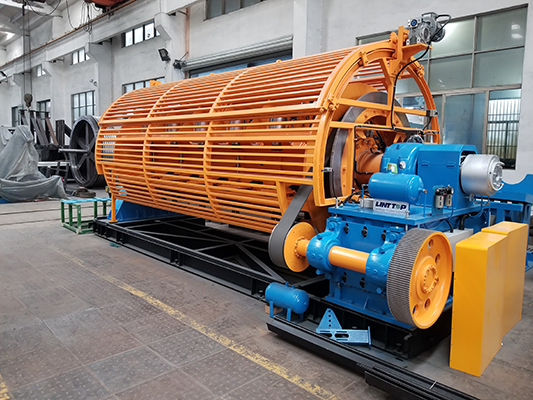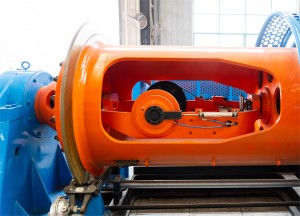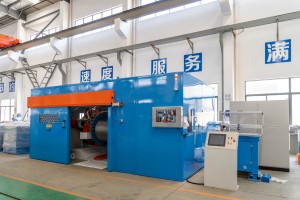Stranding not only includes the twisting and bundling of conductors, but also the twisting (cabling) of insulated wire cores, and the twisting of cable core components. Based on this, LINT TOP only elaborates and discusses the twisting and bundling of conductors.
1. Overview of Conductor Stranding
Conductor stranding refers to stranding several single wires of the same diameter or different diameters together in a certain direction and certain rules to form an overall stranded core. Because it is difficult to bend and has poor flexibility when using a single wire, it brings difficulties to production, transportation, installation, laying and use. Moreover, the cross-section of a single wire is large and the eddy current loss is large, which affects the power transmission effect. The use of stranded conductor effectively avoids these problems.
When the stranded wire is used directly as a wire, it is called bare stranded wire, such as steel core aluminum stranded wire. If it is used as a conductor for insulated wires and cables, it is called stranded wire core.
(1)Characteristics of conductor stranding
A.Good flexibility.
Because wires and cables are used in different situations, the carrying capacity is different, and the conductor cross-sections are different. As the conductor cross-section increases, the conductor diameter also increases, making it difficult to bend the conductor. If multiple small-diameter single wires are twisted together, the bending ability of the wires can be improved, which facilitates the processing, manufacturing, installation and laying of wires and cables.
B. Good stability
A stranded wire core in which multiple single wires are twisted together in a certain direction and certain rules. Since the position of each single wire in the stranded wire is alternately in the elongation zone of the upper part of the stranded wire and the compression zone of the lower part of the stranded wire, When both ends of the stranded wire are bent downward, the elongation force and compression force on each single wire are equal. The single wire will not elongate or compress, and the stranded wire will not deform.If multiple single wires are not twisted but combined in parallel to form a wire harness, then when the wire harness is bent, the upper single wires will be embedded in the wire harness, and the lower single wires will also be compressed toward the center of the wire harness due to the change in length, thus changing the shape of the wire harness.
C. Good reliability
Using a single wire as a conductor for wires and cables is susceptible to material inhomogeneity or manufacturing defects that affect the reliability. With multiple single-wire stranded cores, such defects can be dispersed and will not be concentrated on a certain point of the conductor. The reliability of the conductor is much stronger. This situation is especially obvious at the joints of the conductor.
D.High strength
Compared with a single wire of the same cross-section size and multiple stranded wires, the strength of the stranded wire is higher than that of a single wire of the same cross-section.
(2)Conductor stranding form
Conductor stranding includes the stranding and bundling of conductors, and its stranding forms are mainly divided into two types: regular stranding and irregular stranding (bundling). Regular stranding can be divided into two types: regular concentric single wire stranding and regular concentric stranded wire stranding (compound stranding). Regular concentric single wire stranding can be divided into two types: ordinary stranded wire (copper and aluminum stranded wire) and combined stranded wire (steel core aluminum stranded wire).
2. Conductor stranding equipment
The composition of the stranding machine is basically the same. In addition to the main machine, there are pay-off, traction, take-up, transmission system and control system. LINT TOP supplies tubular stranding machine, rigid frame stranding machine, skip type stranding machine, planetary stranding machine, concentric stranding machine and bunching machine, etc.
(1)Tubular stranding machine
The tubular stranding machine is a high-speed stranding machine with back-twist, which is widely used in the stranding of copper wire, aluminum wire and steel core aluminum stranded wire. The tubular stranding machine is mainly composed of a pay-off frame, a stranding cage, a parallel mold base, a meter counter, a traction wheel, and a take-up and arrangement frame. Since only the cage rotates, it is light in weight and has a small rotation radius, so it can reach very high speeds.
(2)Rigid frame stranding machine
The rigid frame stranding machine consists of a stranding cage, a parallel mold base, a pressing mold base, a meter counter, a traction device, a take-up frame and an electrical control cabinet. The bobbins are divided into four vertically arranged frames. The central axis is not subject to the weight load of the wire bobbins. The wire bobbins are distributed at an angle of 90° in the circumferential direction of the rotating cage. Each group is arranged in a straight line. The rotation radius of the cage is small, and its rotational speed is twice that of the planetary stranding machine of the same specifications.

The rotating cage does not use supporting wheels, but is supported by large bearing seats at both ends. The equipment has low noise. The wire bobbin can be moved up and down individually or as a whole. It is clamped by pneumatic or electric power. It is easy to operate, shortens the auxiliary time, and is beneficial to realize mechanization and automation of loading and unloading bobbins.
(3)Bunching machine
If the diameter of the single wire is required to be very thin and the twisted wire is particularly soft, the above-mentioned stranding machine cannot be used, and only the bunching machine can be used. Multiple single-line pay-off bobbins are placed on the fixed bracket in layers and in rows, and enter the host of the bundling and take-up reels through the distribution board. The single wire is twisted due to the rotation of the rotary body. Since the bunching machine operates in the wire take-up part, and the speed changer is installed in the rotating hoop, the location is limited. This determines that the wire harness machine can only produce a product with a twist direction and smaller specifications.


